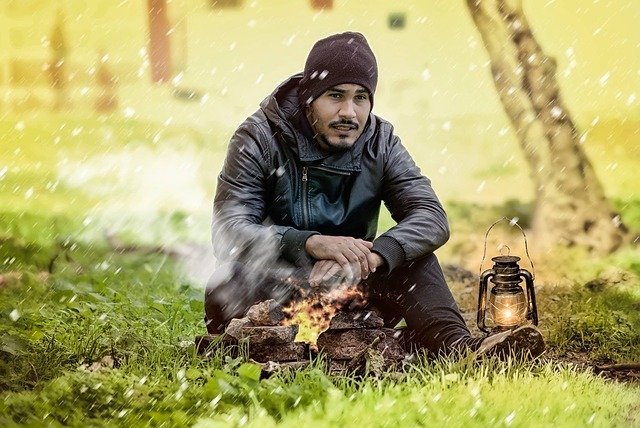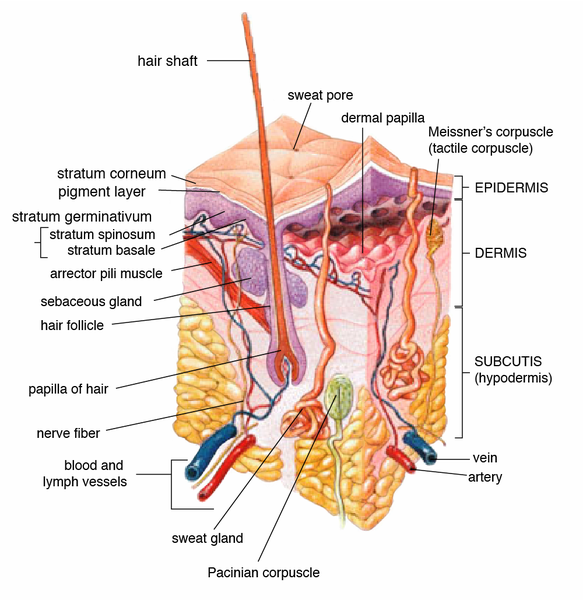How is Temperature Regulated in Mammals? #2
Dear readers. Thank you for the comments and support. This will be the concluding part to my last post on How is temperature regulated in mammals? So, I will start today’s post with the problems associated with extreme temperatures.
Did you know that humans can maintain a stable body temperature over a wide range of external temperatures. But what happens when we are no longer able to thermoregulate effectively, and our internal temperature changes? What happens to people stranded in the desert under a baking sun, or to those trapped in freezing water?

Experiments have been carried out in which a naked man is asked to sit in a room while the temperature around him is gradually raised or lowered. It is observed that throughout the range 15 °C to 30 °C the naked man is easily able to maintain a constant core temperature. As the temperature increases, a point is reached, however, when his sweating and vasodilation are no longer able to keep him cool and he is said to have reached the upper critical temperature. After this, his metabolic rate starts to rise, but the experiment is always stopped at this point. If it were not, a positive feedback would begin. The man’s enzymes would work faster and consequently make even more heat, raising his temperature further. At about 42 to 44 °C, the upper lethal temperature would be reached and he would die.
If the same type of experiment is done, but temperature is lowered, shivering and vasoconstriction help the man keep his core body temperature constant until the room drops to about 3°C. After that, the room becomes so cold that the body is no longer able to maintain a constant core: the lower critical temperature has been reached. At this point the metabolic rate begins to rise, and this helps the situation by generating more heat. Again, the experiment is always halted at this stage but, if heat loss were allowed to continue, a lower lethal temperature would be reached and the subject would die.
Can we keep people alive by freezing them? Can people suffering from incurable diseases be put into deep-freeze until such time as a cure is found, and then revived? The simple answer is no. It is not possible to freeze people and bring them back to life. One of the main problems is that the formation of ice crystals destroys the cells, but a critical factor in maintaining life seems to be the timescale involved: ice crystals take time to develop. When very small samples are immersed in liquid nitrogen, the freezing process happens rapidly: all the molecules simply ‘lock’ in position and ice crystals do not form. The cells and organelles are not damaged, and, when thawed, function normally. This technique, however, only works with tiny samples of tissue, which freeze instantly and entirely. Let’s look into the structure of the human skin to understand how it responds to heat and temperature.
The skin is in direct contact with the external environment and so plays a central role in maximizing or minimizing heat loss. The figure below shows the structure of mammalian skin.

Structurally, the skin is divided into two layers, the outer epidermis and the dermis underneath. Forming the boundary between the two is the Malphighian layer, the function of which is to produce new epidermal cells by mitosis. These cells make the protein keratin, and once they are pushed up into the epidermis they flatten, die and dry up because they have no blood supply. We are constantly losing epidermal cells in a process called desquamation. House dust is mainly desquamated skin cells, and a significant proportion of the mass of our mattresses and pillows is due to accumulated skin cells (one estimate says that skin adds one per cent to the weight of your mattress every year).source
The dermis is much thicker than the epidermis, and contains many different structures such as nerve endings, hair follicles and blood vessels, held together with elastic connective tissue. Beneath the dermis is the hypodermis that usually contains at least some subcutaneous fat. This fat storage tissue, called adipose tissue, determines human body shape to a large extent. Human skin has several functions:
It detects stimuli using cells that are sensitive to heat, cold, touch, pressure and pain. It prevents excessive water loss or gain. It plays a role in thermoregulation by adjusting heat loss according to the circumstances. It prevents entry of microorganisms. It secretes hair, fingernails and toenails. It allows subtle forms of communication. We secrete natural scents, pheromones, from modified sweat glands.
THERMOREGULATION: Physiological responses to cold
There are four main physiological responses when the hypothalamus detects a drop in blood temperature:
The first is that we tend to shiver when muscles contract and relax rapidly. Shivering muscles give out four or five times as much heat as resting muscles. The second is vasoconstriction and this occurs when the arterioles that lead to the capillaries in the surface layers of the skin constrict (narrow), so reducing blood flow to the skin surface. This cuts down the amount of heat lost through the skin. Vasoconstriction Is controlled by sympathetic nerves that pass from the vasomotor centre in the brain. This centre, in turn, receives information from the hypothalamus.
The third is piloerection and this means literally ‘erection of hairs and involves a reflex. In most mammals, piloerection makes the fur ‘thicker’, so that it traps more air to provide extra insulation. In humans, the erector pili muscles in the skin pull our tiny hairs upright, but only succeed in creating goose pimples. The fourth is the increase in the metabolic rate. The body secretes the hormone adrenaline in response to cold. This raises metabolic rate and therefore increases heat production. People who live in cold conditions for a period of several weeks or months show a more permanent increase in metabolic rate because of the secretion of thyroxine.
Physiological responses to heat
There are two main physiological responses to heat: Vasodilation; this occurs when arterioles that lead to skin capillaries dilate and shunt vessels are closed off, resulting in a greatly increased blood flow to the skin. As a result, more heat can be lost to the environment. Coupled with sweating, vasoconstriction is a very effective cooling mechanism. The second is sweating which is the production of a salty solution by sweat glands. Evaporation of sweat from the skin’s surface leads to cooling. The efficiency of sweating depends on the humidity. In dry air, humans tolerate temperatures of 65 °C for several hours. In humid air, however, when the sweat cannot evaporate, temperatures of only 35 °C (lower than the core body temperature) cause overheating.
Finally on Hypothermia……..
I will like to end this discussion by explaining what hypothermia is all about. The definition of hypothermia is a drop in core temperature to 35°C or below. This condition is very common, and is regularly seen in elderly people and in people who have been immersed in cold water – such as those caught in shipwrecks or people who fall through ice.
People can be revived from the most extreme states of hypothermia, even when all the vital signs point to death. People with severe hypothermia who were cold and blue, showing no heartbeat or breathing and with fixed and dilated pupils, have been revived and have later recovered.
There are several stages of hypothermia. When someone’s core body temperature drops to 36 °C, they are in a state of impending hypothermia they start to feel uncomfortable and their skin gets pale, numb and waxy. Their muscles tense, they shiver and they feel tired and weak. This progresses to mild hypothermia. Core temperature drops below 35 °C. Uncontrolled, intense shivering begins. Victims are alert and aware of the situation and so may still be able to help themselves but their movements become clumsy and the cold causes pain and discomfort.
If there is no escape from the cold and core temperature drops below 33 °C, moderate hypothermia is reached. Shivering slows or stops, muscles begin to stiffen and the victim becomes confused and apathetic. Speech becomes slow and difficult to understand. Drowsiness and eccentric behaviour can follow. Finally, in severe hypothermia, the core temperature falls below 31 °C. The person’s skin is cold and often bluish-grey and his or her eyes are dilated. He or she may often seem drunk and deny that there is a problem. There is a gradual loss of consciousness. In extreme cases the victim can appear dead, being rigid and not breathing.

The basic goals of hypothermia treatment are to stabilize the core temperature and to prevent cardiac arrest. One of the body’s first responses to cold is peripheral vasoconstriction, and wrapping the victim in a blanket and allowing him or her to warm up gently while preventing excessive heat loss is effective. Heating the skin directly is not a good idea because it causes vasodilation that returns cold blood to the body core. This leads to a sudden further drop in core body temperature that can stop the heart.
In conclusion
Animals are divided into two groups according to their ability to thermoregulate: endotherms (heat from within’) maintain a stable core temperature by behavioural and physiological means; ectotherms maintain a relatively steady body temperature using behaviour only. Humans, like all mammals, are ectotherms. Mammals are also said to be warm-blooded, or homoiothermic. This means that they can maintain a stable core body temperature despite changes in the external temperature.
Also, to maintain a stable body temperature, heat loss must equal heat gain and unless the climate is very hot, mammals regulate body temperature by producing heat as a result of metabolic reactions, and by controlling how much of it is lost to the environment. When mammals are hot, they maximise heat loss; when they are cold, mammals try to lose as little heat as possible.
I also explained that heat is transferred in four ways: conduction, convection, evaporation and radiation. Temperature receptors in human skin provide an early warning system for temperature change, allowing us to thermoregulate by our behaviour (altering position, clothing, etc.). This often prevents the need for a physiological response.
The hypothalamus can detect the temperature of the blood in the core ot the body. If the blood temperature drops, the hypothalamus initiates corrective responses such as vasoconstriction and shivering. If the blood temperature increases, we respond by vasodilation and sweating. These are physiological responses.
Finally, extremes of both heat and cold can cause death and death from cold occurs as a result of hypothermia; which is common in people who have fallen into freezing water. Thank you for reading.
REFERENCES
- https://www.health.harvard.edu/staying-healthy/when-is-body-temperature-too-low
- https://www.dummies.com/education/science/anatomy/body-maintains-constant-temperature-thermoregulation/
- https://wwwnc.cdc.gov/travel/yellowbook/2012/chapter-2-the-pre-travel-consultation/problems-with-heat-and-cold.htm
- https://www.cdc.gov/climateandhealth/effects/temperature_extremes.htm
- https://www.aap.org/en-us/advocacy-and-policy/aap-health-initiatives/Children-and-Disasters/Pages/Extreme-Temperatures-Heat-and-Cold.aspx
- https://www.encyclopedia.com/science/dictionaries-thesauruses-pictures-and-press-releases/upper-critical-temperature
- https://www.researchgate.net/topic/Dry-Ice
- https://www.woot.com/blog/post/the-debunker-is-most-household-dust-really-human-skin
- https://www.livescience.com/32337-is-house-dust-mostly-dead-skin.html
- https://en.wikipedia.org/wiki/Desquamation
- https://www.britannica.com/science/thermoregulation
- Journals.physiology.org: The basic concepts of thermoregulation
- https://homeostasiseleishabiology.weebly.com/behavioral-and-physiological-reponses.html
- http://aqualyte.com.au/wp-content/uploads/2015/01/PHYSIOLOGICAL-RESPONSE-TO-HEAT-EXPOSURE.pdf
- https://en.wikipedia.org/wiki/Hypothermia
Congratulations @loveforlove! You have completed the following achievement on the Hive blockchain and have been rewarded with new badge(s) :
You can view your badges on your board And compare to others on the Ranking
If you no longer want to receive notifications, reply to this comment with the word
STOPDo not miss the last post from @hivebuzz:
Support the HiveBuzz project. Vote for our proposal!
@tipu curate
Upvoted 👌 (Mana: 14/21)
Thanks for your contribution to the STEMsocial community. Feel free to join us on discord to get to know the rest of us!
Please consider supporting our funding proposal, approving our witness (@stem.witness) or delegating to the @stemsocial account (for some ROI).
Thanks for using the STEMsocial app and including @stemsocial as a beneficiary, which give you stronger support.